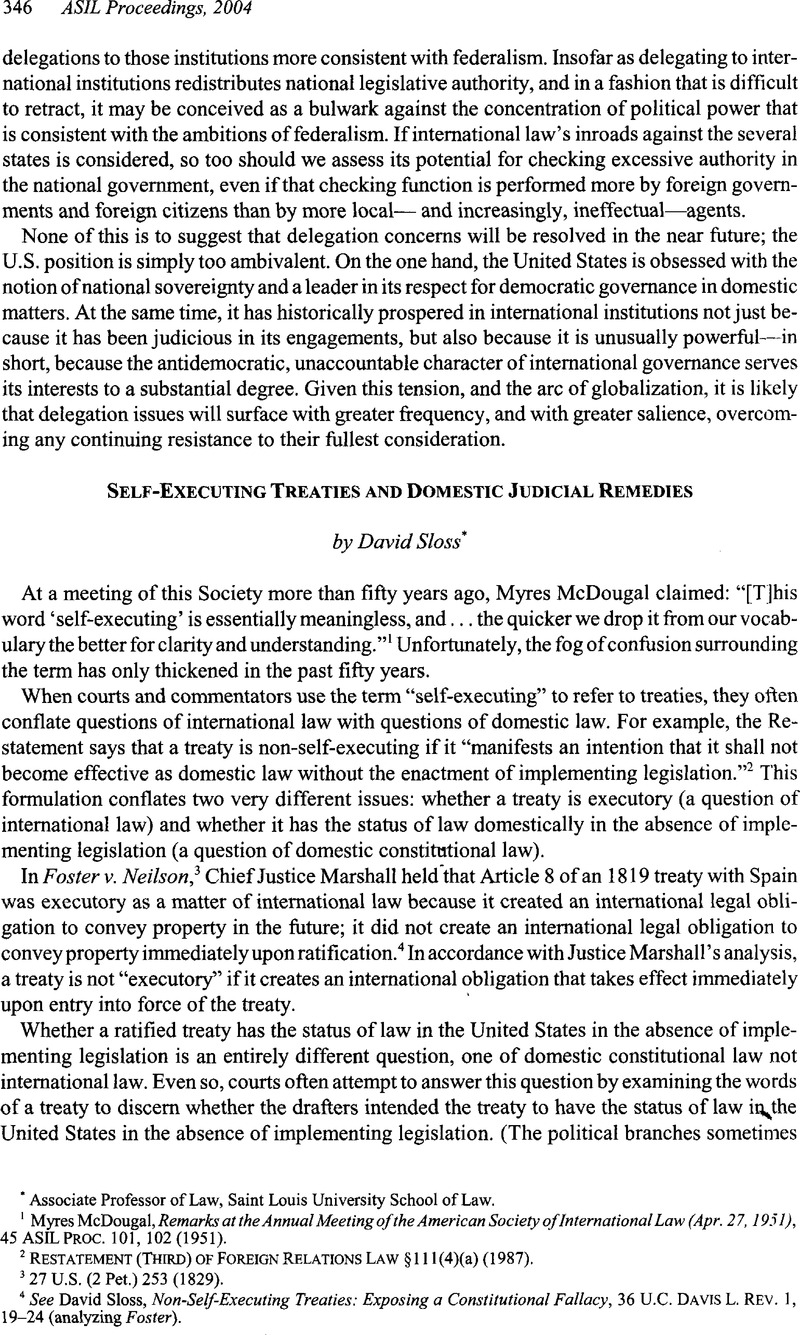No CrossRef data available.
Article contents
Self-Executing Treaties and Domestic Judicial Remedies
Published online by Cambridge University Press: 28 February 2017
Abstract

- Type
- Treaties in U.S. Law: New Debates on Old Ideas
- Information
- Copyright
- Copyright © American Society of International Law 2004
References
1 McDougal, Myres, Remarks at the Annual Meeting of the American Society of International Law (Apr. 27, 1951), 45 ASIL Proc. 101, 102 (1951)Google Scholar.
2 Restatement (Third) Of Foreign Relations Law § 111 (4)(a) (1987).
3 27 U.S. (2 Pet.) 253 (1829).
4 See Sloss, David, Non-Self-Executing Treaties: Exposing a Constitutional Fallacy, 36 U.C. Davis L. Rev. 1, 19–24 (analyzing Foster)Google Scholar.
5 See Riesenfeld, Stefan A., The Doctrine of Self-Executing Treaties and U.S. v. Postal: Win at Any Price? , 74 AJIL 892, 895-96 (1980)CrossRefGoogle Scholar (the question of whether a treaty’s domestic effects are “to be achieved by legislation or by the treaty itself is a question of constitutional law and not within the purview of the intent either of all parties to the treaty or of a particular ratifying power”).
6 U.S. Const, Art. VI, cl. 2.
7 See Sloss, supra note 4, at 46-55 (elaborating this point in greater detail).
8 Supra note 3.
9 See, e.g., Edye v. Robertson (Head Money Cases), 112 U.S. 580, 598 (1884) (distinguishing between treaties that are “primarily a compact between independent nations” and treaties that “confer certain rights upon the citizens or subjects of one of the nations residing in the territorial limits of the other”).
10 See, e.g., Sei Fujii v. State, 242 P.2d 617, 619-22 (Cal. 1952) (holding that articles 55 and 56 of the UN Charter are not self-executing because they merely create a general duty to promote human rights without specifying the particular rights to be protected).
11 See Vienna Convention on Consular Relations, Apr. 24, 1963, 21 UST 77, 596 UNTS 261, art. 36, para. 1 (providing an individual right for detained foreign nationals to consult with a consular officer and obligating states to inform foreign nationals about this right).
12 See, e.g., Tel-Oren v. Libyan Arab Republic, 726 F.2d 774, 808 (D.C. Cir. 1984) (Bork, J., concurring: “Absent authorizing legislation, an individual has access to courts for enforcement of a treaty’s provisions only when the treaty [itself] . . . expressly or impliedly provides a private right of action”).
13 See, e.g., United States v. Duarte-Acero, 132 F.Supp. 2d 1036, 1040 n. 8 (S.D. Fla. 2001) (“Courts have uniformly held that there is no private cause of action under the ICCPR.... However, because Defendant is raising his ICCPR claims defensively, this limitation does not apply.”).
14 See Vazquez, Carlos Manuel, Treaty-Based Rights and Remedies of Individuals, 92 Colum. L. Rev. 1082, 1143-57 (1992)CrossRefGoogle Scholar (discussing rights of action that plaintiffs can use to enforce treaty claims).
15 123S. Ct. 2374(2003).
16 See id. The Supreme Court did not identify the source of the plaintiffs’ private right of action in Garamendi. The Court apparently assumed, sub silentio, that the supremacy clause creates a private right of action for some treaty-based preemption claims against state officers. See Sloss, David, Ex parte Young and Federal Remedies for Human Rights Treaty Violations, 75 Wash. L. Rev. 1103 (2000)Google Scholar (contending that the supremacy clause creates an implied private right of action for certain treaty-based preemption claims).
17 See, e.g., LaGrand (Germany v. United States of America) (Judgment of June 27, 2001) paras. 79-91, available at <http://www.icj-cij.org> (holding that the United States was obligated to give the LaGrand brothers domestic judicial remedies for violation of their rights under article 36 of the Vienna Convention, even though the Convention is silent with respect to domestic remedies).
18 Non-self-executing declarations clearly express the intent of the political branches to limit domestic judicial remedies for treaty violations, but such declarations should not be construed as a complete bar to domestic judicial remedies. See Sloss, David, The Domestication of International Human Rights: Non-Self-Executing Declarations and Human Rights Treaties, 24 Yale J. Int’l L. 129 (1999)Google Scholar (contending that some judicial applications of human rights treaties are consistent with the treaty makers’ intent in adopting non-self-executing declarations). See also Sloss, supra note 4, at 41-44 (contending that the Constitution mandates judicial remedies for treaty violations in some cases).




